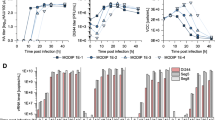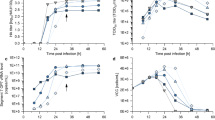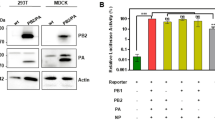Abstract
During the replication of influenza viruses, defective interfering particles (DIPs) can be generated. These are noninfectious deletion mutants that require coinfection with a wild-type virus but interfere with its helper virus replication. Consequently, coinfected cells mainly produce DIPs. Little is known about how such noninfectious virus particles affect the virus yield of cell culture-based influenza vaccine production. We compared infections of Madin-Darby canine kidney cells with two seed virus preparations of the influenza virus strain A/Puerto Rico/8/34 that contain different amounts of DIPs. A combination of conventional RT-PCR, RT-qPCR, and flow cytometry revealed that DI genomes indeed strongly accumulate in coinfected cells and impede the viral RNA synthesis. Additionally, cells infected at the higher DIP concentration showed a stronger antiviral response characterized by increased interferon-β expression and apoptosis induction. Furthermore, in the presence of DIPs, a significant fraction of cells did not show any productive accumulation of viral proteins at all. Together, these effects of DIPs significantly reduce the virus yield. Therefore, the accumulation of DIPs should be avoided during influenza vaccine production which can be achieved by quality controls of working seed viruses based on conventional RT-PCR. The strategy for the depletion of DIPs presented here can help to make cell culture-based vaccine production more reliable and robust.





Similar content being viewed by others
References
Aggarwal K, Jing F, Maranga L, Liu J (2011) Bioprocess optimization for cell culture based influenza vaccine production. Vaccine 29(17):3320–3328. doi:10.1016/j.vaccine.2011.01.081
Audsley JM, Tannock GA (2008) Cell-based influenza vaccines: progress to date. Drugs 68(11):1483–1491
Balachandran S, Roberts PC, Kipperman T, Bhalla KN, Compans RW, Archer DR, Barber GN (2000) Alpha/beta interferons potentiate virus-induced apoptosis through activation of the FADD/Caspase-8 death signaling pathway. J Virol 74(3):1513–1523
Baum A, Sachidanandam R, Garcia-Sastre A (2010) Preference of RIG-I for short viral RNA molecules in infected cells revealed by next-generation sequencing. Proc Natl Acad Sci U S A 107(37):16303–16308. doi:10.1073/pnas.1005077107
Fulvini AA, Ramanunninair M, Le J, Pokorny BA, Arroyo JM, Silverman J, Devis R, Bucher D (2011) Gene constellation of influenza A virus reassortants with high growth phenotype prepared as seed candidates for vaccine production. PLoS ONE 6(6):e20823. doi:10.1371/journal.pone.0020823
Gaush CR, Smith TF (1968) Replication and plaque assay of influenza virus in an established line of canine kidney cells. Appl Microbiol 16(4):588–594
Genzel Y, Reichl U (2007) Vaccine production—state of the art and future needs in upstream processing. In: Pörtner R (ed) Methods in Biotechnology: Animal Cell Biotechnology - Methods and Protocols, vol 24, 2nd. Humana Press Inc., Totowa, NJ, pp 457–473
Genzel Y, Reichl U (2009) Continuous cell lines as a production system for influenza vaccines. Expert Rev Vaccines 8(12):1681–1692. doi:10.1586/erv.09.128
Gerdil C (2003) The annual production cycle for influenza vaccine. Vaccine 21(16):1776–1779
Hoffmann E, Stech J, Guan Y, Webster RG, Perez DR (2001) Universal primer set for the full-length amplification of all influenza A viruses. Arch Virol 146(12):2275–2289
Huang AS, Baltimore D (1970) Defective viral particles and viral disease processes. Nature 226(5243):325–327
Isken B, Genzel Y, Reichl U (2012) Productivity, apoptosis, and infection dynamics of influenza A/PR/8 strains and A/PR/8-based reassortants. Vaccine 30(35):5253–5261. doi:10.1016/j.vaccine.2012.05.065
Jennings PA, Finch JT, Winter G, Robertson JS (1983) Does the higher order structure of the influenza virus ribonucleoprotein guide sequence rearrangements in influenza viral RNA? Cell 34(2):619–627
Jorba N, Coloma R, Ortin J (2009) Genetic trans-complementation establishes a new model for influenza virus RNA transcription and replication. PLoS Pathog 5(5):e1000462. doi:10.1371/journal.ppat.1000462
Kalbfuss B, Knochlein A, Krober T, Reichl U (2008) Monitoring influenza virus content in vaccine production: precise assays for the quantitation of hemagglutination and neuraminidase activity. Biologicals 36(3):145–161
Kawakami E, Watanabe T, Fujii K, Goto H, Watanabe S, Noda T, Kawaoka Y (2011) Strand-specific real-time RT-PCR for distinguishing influenza vRNA, cRNA, and mRNA. J Virol Methods 173(1):1–6
Marcus PI, Ngunjiri JM, Sekellick MJ (2009) Dynamics of biologically active subpopulations of influenza virus: plaque-forming, noninfectious cell-killing, and defective interfering particles. J Virol 83(16):8122–8130
Merten OW, Hannoun C, Manuguerra JC, Ventre F, Petres S (1996) Production of influenza virus in cell cultures for vaccine preparation. Adv Exp Med Biol 397:141–151
Nayak DP, Chambers TM, Akkina RK (1985) Defective-interfering (DI) RNAs of influenza viruses: origin, structure, expression, and interference. Curr Top Microbiol Immunol 114:103–151
Roedig JV, Rapp E, Hoper D, Genzel Y, Reichl U (2011) Impact of host cell line adaptation on quasispecies composition and glycosylation of influenza A virus hemagglutinin. PLoS ONE 6(12):e27989. doi:10.1371/journal.pone.0027989
Schulze-Horsel J, Schulze M, Agalaridis G, Genzel Y, Reichl U (2009) Infection dynamics and virus-induced apoptosis in cell culture-based influenza vaccine production-flow cytometry and mathematical modeling. Vaccine 27(20):2712–2722
Seitz C, Isken B, Heynisch B, Rettkowski M, Frensing T, Reichl U (2012) Trypsin promotes efficient influenza vaccine production in MDCK cells by interfering with the antiviral host response. Appl Microbiol Biotechnol 93(2):601–611. doi:10.1007/s00253-011-3569-8
Tree JA, Richardson C, Fooks AR, Clegg JC, Looby D (2001) Comparison of large-scale mammalian cell culture systems with egg culture for the production of influenza virus A vaccine strains. Vaccine 19(25–26):3444–3450
Ulmer JB, Valley U, Rappuoli R (2006) Vaccine manufacturing: challenges and solutions. Nat Biotechnol 24(11):1377–1383. doi:10.1038/nbt1261
von Magnus P (1951) Propagation of the PR8 strain of influenza A virus in chick embryos. II. The formation of incomplete virus following inoculation of large doses of seed virus. Acta pathologica et microbiologica Scandinavica 28(3):278–293
Acknowledgments
We thank Frank Stefan Heldt, Tanja Laske, and Andrew Easton for critical comments on the manuscript. In addition, the authors would like to thank Stefanie Luetzner and Nancy Wynserski for excellent technical assistance. Mandy Bachmann is supported by a grant of the German Federal Ministry of Education and Research as part of the e:Bio initiative.
Conflict of interest
The authors declare that they have no conflict of interest.
Author information
Authors and Affiliations
Corresponding author
Additional information
Timo Frensing and Antje Pflugmacher contributed equally to this work.
Electronic supplementary material
Below is the link to the electronic supplementary material.
ESM 1
(PDF 787 kb)
Rights and permissions
About this article
Cite this article
Frensing, T., Pflugmacher, A., Bachmann, M. et al. Impact of defective interfering particles on virus replication and antiviral host response in cell culture-based influenza vaccine production. Appl Microbiol Biotechnol 98, 8999–9008 (2014). https://doi.org/10.1007/s00253-014-5933-y
Received:
Revised:
Accepted:
Published:
Issue Date:
DOI: https://doi.org/10.1007/s00253-014-5933-y




